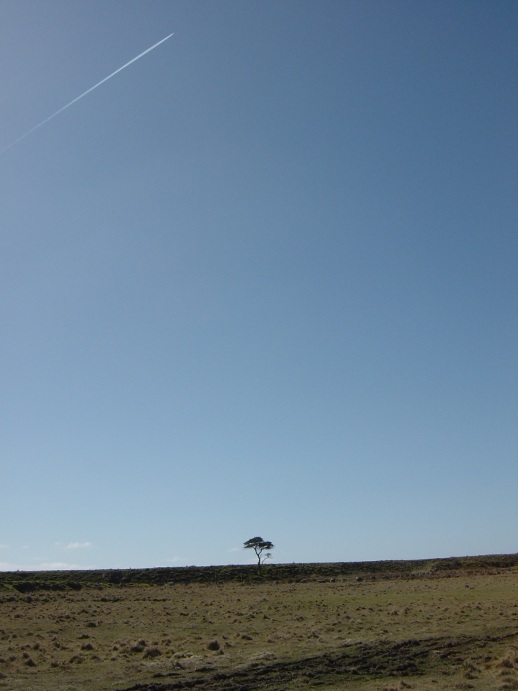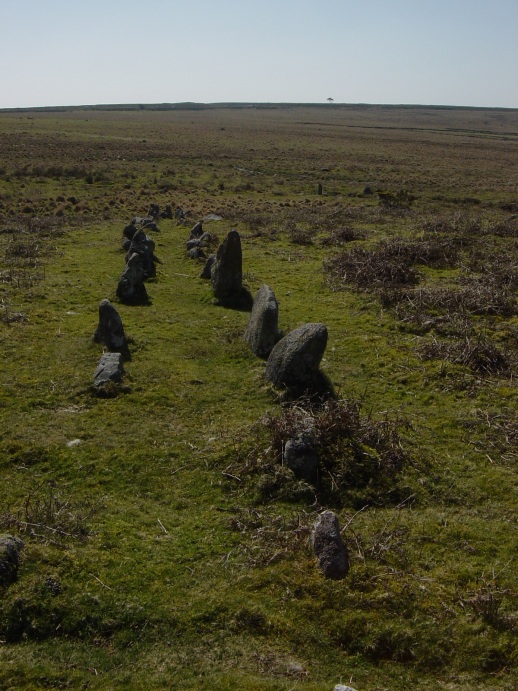From West Country correspondent, Mr. Alex Smith:
Arriving at Cadover Bridge, I turned off along the river and headed up to where Blacka Brook meets the young Plym. A few miles downstream from the spring at Plym Head, the flow was poor for this time of year. In normal circumstances Dartmoor absorbs massive amounts of rain and lets it run out gradually over the year into the rivers and streams that fall off its southern flanks. The recent dry winter had exhausted the sponge of most of its moisture and this time the Plym was weak and coloured with peat and revealing occasional glimpses of its pebble-strewn bottom.
My route for this walk consisted of a short hop from here to a point a little below Little Trowlesworthy Tor, then an amble up to Great Trowlesworthy, a slog up to Shell Top and a short lunch at Penn Beacon. The haze would probably filter the view but this high ground is always worth the trip. My return would be along the lower slopes, peering into the wound that is Lee Moor china clay pit, then an easy run along the leat to the megalithic complex at Trowlesworthy and a return to the start via Blackaton Cross and the sentinel tree at Big Pond.
There were highland cattle on the slopes below Little Trowlesworthy, just a small recently introduced group, and a few ponies in amongst the sheep brought down from the hill for lambing. The better mothers lined their lambs up in the shade of the dry stone walls, out of the direct influence of the weak spring sun. The wind was stronger up here but warm enough for shirtsleeves. Skylarks set off as I passed them and started their song even as they climbed.
There were skylarks again at Great Trowlesworthy and some small groups of a bird I didn’t recognise. A couple of dozen or so per group, they’d lift up as one, white flashes from their undersides and the sounds of the estuary about them. Then a return to earth a hundred yards or so along from the original site, arguments eventually settling into feeding. They navigated the flatter, greener areas close to the tor in this manner for the duration of my incursion.
The view from Shell Top is always a joy but on this occasion the mist robbed me of the great distances that such a high crow’s nest would ordinarily provide. The fore and middle ground were impressive still, if a little underexposed, but the distant horizon faded into a wishy washy sky. Although not a bad reward for those three hundred metres or so of climb, I have had much better here. And worse, of course, this is a hill to climb in winter with the right gear and a full flask. I had my lunch beside Penn Beacon peering down into Cholwitch Town Bottom, with the disused Wotterwaste behind. The brilliant white of the clay walls reflected off the water pooling on the pit floor and, as I made my way down and onto the perimeter track, I got a good view of the clay thickening tanks on the opposite side, resembling a dusty, treeless, Tracy Island. I followed the track past the Whitehill Yeo works and walked the bank of the leat to Trowlesworthy stone circle and the stone rows.
Probably a barrow cemetery, the megalithic compound at Trowlesworthy is a favourite. It has single, double and triple stone rows and two stone rows leading off from stone circles. The stones are mostly upright with only a few left to fall and sink untidily into the peaty floor. Dartmoor has so many of these treasures, unmarked and left casually laying about, that it is all too easy to disregard their importance. These ones are not all that photogenic, when all’s said and done they’re just a bunch of well placed stones, but their place in Dartmoor’s history is palpable. This compound is between three and a half and five and a half thousand years old. Almost certainly a place of worship as well as burial, the true purpose of the stone rows is still up for debate. When first used, the compound would have been a clearing in a shallow wooded valley at a time when Dartmoor was mostly all trees. A period many lifetimes before the wood was carted off to make ships and houses in Plymouth and beyond. Long, long before the moor was turned over to grazing and the colonising gorse and bracken gave us the vistas that we now know as classic Dartmoor. It was a different place then.
Up the hill from here, at one of the highest points around, is a defiant tree guarding the perimeter wall at Big Pond. It stands absolutely alone and can be seen from all the routes the local walker is likely to travel. We call it the sentinel tree and I made my way up to it on a track skirting the clay works’ boundary. It sits close to the restored Blackaton cross and both were worth the climb before starting the descent back to the start. Three and a half hours. Ideal.

